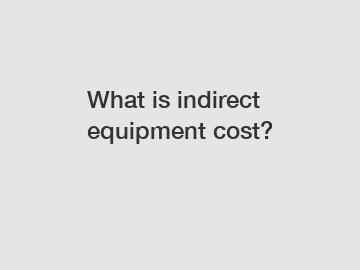What is indirect equipment cost?
In the realm of business operations, calculating costs accurately is crucial to maintaining profitability and making informed decisions. While many businesses are well-versed in accounting for direct costs associated with equipment, such as the purchase price and maintenance expenses, indirect equipment costs often lurk in the shadows. In this blog post, we will shed light on indirect equipment costs, their impact on businesses, and strategies to effectively account for them.
What are Indirect Equipment Costs?
Indirect equipment costs encompass the expenses that arise from the utilization and ownership of equipment, but are not directly attributed to a particular machine or tool. These costs typically go beyond immediate expenditures and include expenses that are shared across various pieces of equipment within an organization.

Indirect costs can encompass a wide range of items, including but not limited to:
1. Overhead Expenses: Indirect equipment costs often include expenses like rent, utilities, and insurance that are incurred to maintain the equipment's operational environment. These overhead costs contribute to the overall cost of using and maintaining equipment.
2. Depreciation: Equipment depreciation is an indirect cost that arises from the reduction in value over time due to wear and tear, obsolescence, or market conditions. Tracking and accounting for equipment depreciation is essential for proper financial reporting and investment decisions.
3. Indirect Labor: Costs associated with labor that supports equipment, such as technicians, machine operators, or maintenance personnel, are indirect equipment costs. These labor expenses are essential for ensuring smooth equipment operations.
4. Repair and Maintenance: While direct costs may include routine maintenance expenses, indirect costs comprise unexpected breakdowns and major repairs that impact multiple pieces of equipment. Such unforeseen costs can be significant and should be factored into overall equipment cost calculations.
5. Training and Skill Development: Costs associated with training employees to operate or maintain equipment fall under indirect equipment expenditure. Ensuring a skilled workforce translates into efficient and cost-effective equipment usage in the long run.
The Impact of Indirect Equipment Costs:
Neglecting to account for indirect equipment costs can have detrimental effects on business profitability and sustainability. Failing to consider these expenses may lead to an inaccurate financial picture and hinder effective decision-making. Here are some key reasons why understanding indirect equipment costs is essential:
1. Accurate Budgeting: By recognizing indirect costs, businesses can develop more accurate budgets, enabling them to allocate resources effectively. Proper financial forecasting can help avoid unexpected expenses and maintain a healthy bottom line.
2. Better Evaluations: Understanding indirect costs allows businesses to evaluate the true cost of equipment ownership and utilization accurately. This insight aids in assessing the profitability of various equipment and determines if replacements or upgrades are required.
3. Optimized Equipment Management: Recognizing indirect costs helps identify areas where operational efficiency and cost savings can be achieved. Careful analysis of indirect expenses may reveal opportunities for preventive maintenance, higher equipment utilization rates, or streamlined processes.
4. Informed Decision-making: Ignoring indirect costs can lead to poor investment decisions. Understanding the full cost of equipment ownership enables businesses to make informed choices regarding asset acquisition, leasing, or outsourcing.
Accounting Strategies for Indirect Equipment Costs:
To effectively account for indirect equipment costs, businesses need to implement sound accounting practices. Consider the following strategies:
1. Comprehensive Cost Tracking: Implementing robust cost tracking systems can capture all indirect equipment expenses, ensuring they are not overlooked. Proper categorization and documentation facilitate accurate financial analysis and reporting.
2. Life Cycle Cost Analysis: Conducting a thorough life cycle cost analysis is vital to understanding the true cost of equipment ownership. This analysis should encompass purchase price, maintenance, repairs, labor, and any other relevant expenses over the equipment's projected lifespan.
3. Regular Auditing: Conducting regular audits allows businesses to identify and address discrepancies or inefficiencies related to indirect equipment costs. This practice ensures that financial records align with actual expenses, aiding in better cost analysis and management.
4. Embrace Technology: Utilizing advanced software and equipment management solutions provides real-time data and insights. Automation and digitization streamline the tracking, reporting, and analysis of indirect equipment costs, saving time and reducing errors.
Conclusion:
Indirect equipment costs, though often overlooked, are a critical aspect of maintaining accurate financial records and making informed business decisions. Recognizing and accounting for these expenses is essential for budgeting, evaluating profitability, optimizing equipment management, and making sound investment choices. By embracing comprehensive tracking systems, life cycle cost analysis, regular audits, and technological advancements, businesses can effectively manage and mitigate the impact of indirect equipment costs. Remember, a holistic understanding of all expenses associated with equipment is key to achieving sustainable success.
If you want to learn more, please visit our website oem rapid mold, rapid tooling suppliers, oem rapid injection molding factory.

Comments
0